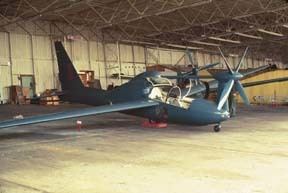Top speed 254 km/h | Length 9.37 m | |
 | ||
The X-26 Frigate is the longest-lived of the X-plane programs. The program included the X-26A Frigate sailplane and the motorized X-26B Quiet Thruster versions: QT-2, QT-2PC, and QT-2PCII. All were based on the Schweizer SGS 2-32 sailplane.
Contents
Development
The X-26A was used by the United States Navy (USN) to train test pilots in the condition of yaw/roll coupling. Since jet trainers were known to be dangerous in this condition, the X-26 was based on the Schweizer SGS 2-32 sailplane. Sailplanes react much slower and are easier to control than jet aircraft, making the X-26 a much safer training platform. Four aircraft were originally ordered. Three of the original planes crashed. The USN purchased a replacement for each of the crashed units.
Operational history
Two Schweizer 2-32s [(67-15345 and 67-15346) from the U.S. Naval Test Pilot School X-26 Program (USNTPS)] were modified to QT-2 configuration (QT for Quiet Thruster) by the Lockheed Missiles & Space Co. (LMSC) and civil registered as N2471W and N2472W. In 1967 the aircraft were modified by adding a Continental O-200 engine, V-Belt RPM reduction system, four-bladed fixed pitch wood (Fahlin) propeller, and airframe upgrades.
After demonstrating quiet flight, the aircraft were again modified to military QT-2PC configuration, known only as Tail Numbers "1" and "2", with GFE avionics and camouflage for night operation. They were successfully evaluated in Southeast Asia (Prize Crew OpEval) for covert ("stealth") tactical airborne observation in the spring of 1968 (during Têt). The two QT-2PCs were returned to USNTPS in 1969 and re-designated X-26Bs.
The #1 QT-2PC was re-designated "67-15345" and the #2 aircraft was used for spare parts. The original X-26 glider version was then designated X-26A.
LMSC continued the covert airborne surveillance program with one Q-Star (House Test Aircraft) and eleven pre-production YO-3As.
Survivors
QT-2PC N2472W is currently operated by Mile High Gliding in Boulder, Colorado and is used for aerobatic demonstrations.
The remaining X-26B aircraft was known to most of the original development team as QT-2 N2471W and QT-2PC #1; the location of the remains of the aircraft are unknown.
The other X-26B aircraft (known as QT-2 N2472W and QT-2PC #2) has been retro-verted to SGS 2-32 Configuration and is being operated (and known as “72 Whiskey”) at Mile High Glider in Boulder, Colorado.
The Q-Star was the first aircraft to use a rotary combustion chamber (Wankel) engine. It is currently being returned to flight status.
The YO-3As were tactically evaluated in Southeast Asia from mid-1969 to late 1971. They were later used by the Louisiana Dept of Wildlife & Fisheries (LDWF) and the Federal Bureau of Investigation (FBI) in law enforcement, and by NASA for scientific applications.
YO-3A 69-18005 is on display at the Museum of Flight in Seattle, Washington. YO-3A 69-18006 is on display at the Pima Air and Space, Tucson AZ. YO-3A 69-18007 is in storage at the Western Museum of Flight in Torrance, California. As of 2014, YO-3A 69-18010 (NASA 818) is in flyable storage at Armstrong Flight Research Center.
Accidents
Specifications (X-26A Frigate)
General characteristics
Performance
Specifications (X-26B and QT-2PC)
General characteristics
Performance
